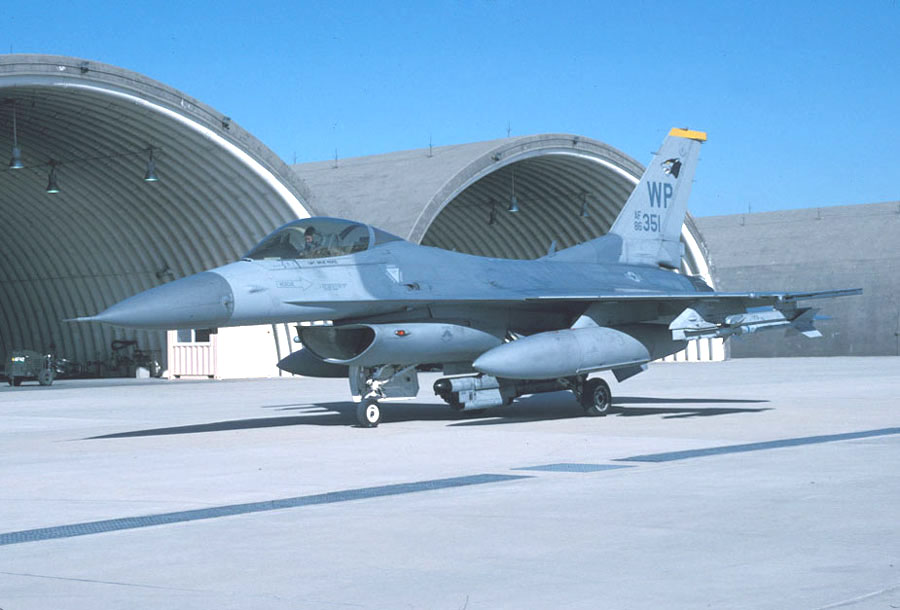Fighter Jet News
F-16 Fighting Falcon News
Wolf Pack F-16 fleet prepares for 'Falcon STAR'
November 30, 2006 (by
SrA Stephen Collier) -
Old. That's one description Wolf Pack maintainers in the 80th Aircraft Maintenance Unit give when describing their block 30 F-16 Fighting Falcon aircraft at Kunsan.
The F-16s, assigned to the 80th Fighter Squadron since the early 1990s, have been upgraded to adapt to an ever-changing mission, adding air-to-ground dominance to air-to-air interdiction. To help extend there life, each F-16 is being inducted into the Air Force's Falcon STAR, or STructural Augmentation Roadmap, program. This upgrade program is expected to keep the fleet ready to Take the Fight North.
Over the years, each F-16 aged more than four times as fast when compared to the original design conceived by General Dynamics and the Air Force in the 1970s. The F-16 remains the fighter of choice in USFK, and as the F-16 continues to adapt to a constantly evolving mission, attaining the aircraft's mandated service life of 8,000 hours "is critically important to the aircraft sustainment community," according to Capt. Christopher Lombardo.
"Quite simply, Falcon STAR replaces the structural components that are aging prematurely," the 8th Maintenance Operations Squadron Operations Officer said. "After the modification, the aircraft will have the newest and most reliable materials needed to take the aircraft through its designed operational life."
Each aircraft, which uses an array of weaponry from GPS guided bombs to radar-guided air-to-air missiles, has a new maximum operational weight of approximately 39,000 pounds; the old, designed weight for the F-16 was only 22,500 pounds. Because of the extra stress put on these airframes, 8th Fighter Wing leadership, in an alliance with Korea Aerospace Industries, are working together to update and harden several areas of the aircraft, including the frame, support beams, and bulkheads.
"This modification benefits the Wolf Pack and the Air Force because we're extending the life span of the F-16," Capt. Lombardo said. "Not only does this modification increase the reliability of the aircraft structure, but it indirectly reduces the sustainment costs by replacing aging items with durable materials."
Modifications on two aircraft are already underway; aircraft 293 and 378 are expected to rejoin the Pack between January and February. Each Wolf Pack F-16 should have its Falcon STAR upgrades completed by early 2008. Falcon STAR is also supported by Air Force Reserve and Air National Guard units supporting F-16 operations.
Over the years, each F-16 aged more than four times as fast when compared to the original design conceived by General Dynamics and the Air Force in the 1970s. The F-16 remains the fighter of choice in USFK, and as the F-16 continues to adapt to a constantly evolving mission, attaining the aircraft's mandated service life of 8,000 hours "is critically important to the aircraft sustainment community," according to Capt. Christopher Lombardo.
"Quite simply, Falcon STAR replaces the structural components that are aging prematurely," the 8th Maintenance Operations Squadron Operations Officer said. "After the modification, the aircraft will have the newest and most reliable materials needed to take the aircraft through its designed operational life."
Each aircraft, which uses an array of weaponry from GPS guided bombs to radar-guided air-to-air missiles, has a new maximum operational weight of approximately 39,000 pounds; the old, designed weight for the F-16 was only 22,500 pounds. Because of the extra stress put on these airframes, 8th Fighter Wing leadership, in an alliance with Korea Aerospace Industries, are working together to update and harden several areas of the aircraft, including the frame, support beams, and bulkheads.
"This modification benefits the Wolf Pack and the Air Force because we're extending the life span of the F-16," Capt. Lombardo said. "Not only does this modification increase the reliability of the aircraft structure, but it indirectly reduces the sustainment costs by replacing aging items with durable materials."
Modifications on two aircraft are already underway; aircraft 293 and 378 are expected to rejoin the Pack between January and February. Each Wolf Pack F-16 should have its Falcon STAR upgrades completed by early 2008. Falcon STAR is also supported by Air Force Reserve and Air National Guard units supporting F-16 operations.
Related articles:
Forum discussion:
Tags
- Ogden ALC delivers first Falcon STAR F-16 (2004-02-11)
- Contract for "Falcon STAR" F-16 upgrade program awarded to Progressive (2003-10-30)
- F-16 Fighting Falcon news archive
Forum discussion:
- Start a discussion about this article in the F-16.net forum.
Tags

